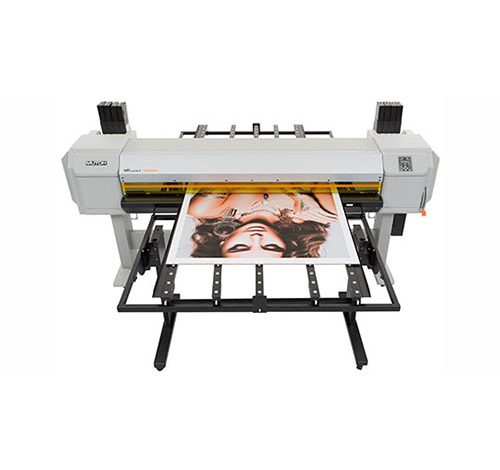How does a thermal sublimation printer work?

Heat Sublimation Printer
Heat sublimation printing is a printing process that uses a carrier material to transfer patterns onto various materials, such as T-shirts or ceramic mugs. Special dye sublimation printers and dye sublimation inks are used for this purpose.
How does the dye thermal sublimation printing process work?
What is the meaning of sublimation? Chemically, sublimation is the rapid transformation of a solid into a gaseous state without passing through the liquid state. For dye sublimation printing on traditional inkjet printers, you will need dye sublimation cartridges and expensive dye sublimation paper. Ghost Sublime toner is used in standard HP brand office laser printers. With our products, there is no longer a need for special paper for dye sublimation printing: you can simply use regular copy paper. The thermal sublimation toner contains thermos sublimation dyes, so it can be transferred to polyester-coated workpieces without the use of special thermos sublimation paper. This requires the use of a transfer machine with a heat transfer temperature of 200 degrees Celsius. This is how polyester fabrics used for T-shirts, pants and jumpers as well as microfiber and other materials are colored.
If you want to put your own design on a light-colored T-shirt, a dye sublimation printer will have the best results because the color penetrates deep into the fabric, not just on the surface application. You will find all the equipment and materials you need in our wide range of products.
Dye-based thermal sublimation printers
Dye sublimation printers with print cartridges and consumables
Which printers are suitable for dye sublimation printing?
Printers suitable for dye sublimation printing usually use water-insoluble disperse dyes (i.e. viscous dyes). These printers are also commonly referred to as sublimation printers or “sublime” printers. Special sublimation printers are required due to the consistency and temperature sensitivity of the ink. Conventional inkjet printers can only use special water-based inks. However, due to contamination of the print head and print tube with residue, changing between regular and special inks is not recommended.
Which media can be used for thermal sublimation printing?
The ideal substrate is polyester, i.e. a fabric with plastic fibers. The polyester content must be at least 80% to achieve the best printing results on a sublimation printer. If other materials are used, such as cotton shirts, ceramic mugs or metal plates, these must be coated with polyester – because the ink does not penetrate deeply into these materials, the pattern does not last long, and natural materials such as cotton burn at high temperatures. Polyester, on the other hand, begins to melt at high temperatures, opening up pores in the fabric where the dye gas penetrates. The ideal background color is white or a light color. Dyed polyester fabrics can only be printed in black.
Heat sublimation blanks
What are the applications of dye sublimation printers?
As long as the material is made of or coated with polyester, the range of applications is almost limitless. Club logos or company names can be printed on T-shirts and workwear; lanyards, cushions and towels can be personalized as gifts or for guests; plaques, mugs, cell phone covers and even skis can be printed.
Advantages of dye sublimation printers
PES or a material consisting of at least 80% polyester is essential for successful printing results. It is also important to choose a light background for printing so that your graphics, logos and photos are perfectly rendered. There is a wide range of heat sublimation printing blankets, such as cell phone covers, key rings, mugs or medals.
Another advantage of dye-sublimation printing is its cost efficiency and speed. This means that you can produce a large number of products in a short time. Promotional items, small gifts and other products can be produced from stock or on demand for special occasions such as stores or exhibitions. With a dye-sublimation printer, you have the ability to produce complex patterns with excellent quality.
Disadvantages of dye sublimation technology
Dye-sublimation printing requires special printers (dye-sublimation printers) and dye-sublimation inks, so the cost is higher than many other methods and the printers are slow. Materials other than polyester can only be used to a limited extent if they can be coated, which is not always possible. White also cannot be printed. So if the design is to contain white or light colors, it must have a white background. In addition, a slight shrinkage of 1-4% must be considered if the design is processed with dye sublimation.
As an alternative to sublimation printing, printing can be done with white toner or white toner printers. In toner transfer, the design is transferred to a transfer foil (A foil), which is then glued to a so-called B paper in the transfer machine. The B-paper contains a heat-activated adhesive that is bonded to the print on the A-foil. After separating the A-foil and B-paper, the design can be transferred to any textile. Unlike the sublimation process, the choice of material is not important here. A wide range of textiles such as cotton, polyester, blended fabrics and felt, but also other materials such as silk, wood or cardboard can be printed. Thanks to the use of white toner, dark and colored backgrounds can also be printed.
Dye-sublimation printing – bundle
Bring your ideas to life with a sublimation printer
Modern designs for marketing and other creative fields can be printed on a variety of surfaces. In addition to paper, cardboard and other materials, the demand for printing on textiles such as T-shirts and bags is also on the rise. Explore our extensive selection to find the perfect printer and the accessories you need. Whether you’re a hobbyist or own a small business or institution, a sublimation printer will allow you to complete your printing projects professionally and quickly.
To print on clothing, you need a dye-sublimation printer, which produces the best results on polyester fabrics. Let us explain how the printing process works and what options are available.




